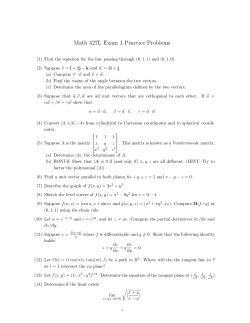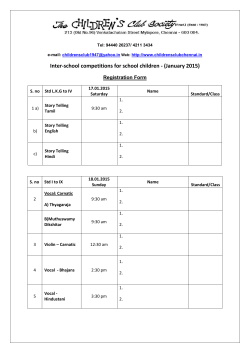
18.06 Problem Set 5
18.06 Problem Set 5 Due Thursday, March 19, 2015, before 4:00 pm (sharp deadline) in Room E17-131 This homework has 4 questions to hand-in. Write down all details of your solutions, NOT JUST THE ANSWERS. Show your reasoning. Please staple the pages together and clearly write your name, your recitation section, and the name of your recitation instructor on the first page of the problem set. Cooperation on problems is permitted, but all solutions must be written up independently and you must list your collaborators on the problem set. You should first try to solve each problem yourself, otherwise you will not learn much from hearing the solution. This homework also has an online part and you can choose whether to do it (self-graded) on MITx with MATLAB or (human-graded) in Julia. Follow the instructions on course website. Problem 1. We are given three points (x1 , y1 ), (x2 , y2 ), (x3 , y3 ) in the plane R2 , and we want to find a line y = C + Dx which minimizes the error term E = (C + Dx1 − y1 )2 + (C + Dx2 − y2 )2 + (C + Dx3 − y3 )2 . Suppose that x1 , x2 , x3 are distinct. ∂E (a) Check that the equations ∂E ∂C = 0 and ∂D =0 are linear with regard to C and C D. Write this system of equations as M = v, where M is a 2 × 2 matrix. D 1 x1 y1 (b) Let A = 1 x2 and b = y2 . Calculate AT A and AT b, and conclude that 1 x3 y 3 C E is minimized when AT A = AT b. D (c) Show that AT A is invertible and our desired line y = C + Dx always exists uniquely. Problem 2. Suppose that vectors q1 , q2 , · · · , qn in Rm are orthonormal. (a) Let c1 , c2 , · · · , cn be real numbers. What is ||c1 q1 + c2 q2 + · · · + cn qn ||2 ? (b) Show that q1 , q2 , · · · , qn are linearly independent. −1 0 0 Problem 3. Let A = 2 2 0. 2 1 3 (a) Find Q and R such that A = QR by Gram-Schmidt process on columns of A. 0 −1 0 (b) Let B = 2 2 0, a matrix obtained by exchanging the first two columns 1 2 3 of A. Find Q0 and R0 such that B = Q0 R0 by Gram-Schmidt process on columns of B. 1 2 Problem 4. Suppose that a function f (x) is defined from 0 to 2π as follows: f (x) = 1 for 0 ≤ x ≤ π and f (x) = 0 for π < x < 2π. Compute the Fourier coefficients ak and bk .
© Copyright 2025





















